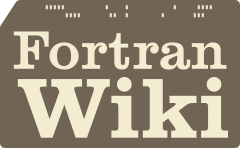Fortran Wiki
Object-oriented programming
Pseudo Object Oriented Style in Fortran 90
Derived types
In object-oriented languages such as C++, one can define classes that contain both data and methods which operate on that data. One can then create separate instances of the class, each with its own data. A method called from an instance of the class will work on the data held by that particular instance.
In Fortran, modules may contain data, but there is no notion of separate instances of a module. In order to obtain class-like behavior, one can combine a module, which contains the methods that operate on the class, with a derived type containing the data. There can be separate “instances” of the type in that we can allocate many variables of that type which can be passed as parameters to the methods contained in the module.
To illustrate these points consider a simple Circle class, based on an example in Akin (2003, p. 34):
module class_Circle
implicit none
private
public :: Circle, circle_area, circle_print
real :: pi = 3.1415926535897931d0 ! Class-wide private constant
type Circle
real :: radius
end type Circle
contains
function circle_area(this) result(area)
type(Circle), intent(in) :: this
real :: area
area = pi * this%radius**2
end function circle_area
subroutine circle_print(this)
type(Circle), intent(in) :: this
real :: area
area = circle_area(this) ! Call the circle_area function
print *, 'Circle: r = ', this%radius, ' area = ', area
end subroutine circle_print
end module class_Circle
program circle_test
use class_Circle
implicit none
type(Circle) :: c ! Declare a variable of type Circle.
c = Circle(1.5) ! Use the implicit constructor, radius = 1.5.
call circle_print(c) ! Call a class subroutine
end program circle_testNOTE: circle_print and circle_area could be made accessible through generic procedure names print and area, respectively. That gets closer to a standard OOP language, because print can be defined for multiple “sub-classed” objects.
Run-Time Polymorphism
- Decyk, V. K. and C. D. Norton (2004). A Simplified Method for Implementing Run-Time Polymorphism in Fortran 95. Scientific Programming 12, 45-55. (PDF)
Object-Oriented Features of Fortran 2003
Type-bound procedures
New features in Fortran 2003 allow us to improve upon the object-oriented approach above by using type-bound procedures which allow us to write
a = c%area
call c%printinstead of the more verbose
a = circle_area(c)
call circle_print(c)If the above example is modified to provide print and area as generic interfaces, it is more concise, even though it does not follow modern OOP syntax:
a = area(c)
call print(c)The program above, modified to use type-bound procedures, looks like this
module class_Circle
implicit none
private
real :: pi = 3.1415926535897931d0 ! Class-wide private constant
type, public :: Circle
real :: radius
contains
procedure :: area => circle_area
procedure :: print => circle_print
end type Circle
contains
function circle_area(this) result(area)
class(Circle), intent(in) :: this
real :: area
area = pi * this%radius**2
end function circle_area
subroutine circle_print(this)
class(Circle), intent(in) :: this
real :: area
area = this%area() ! Call the type-bound function
print *, 'Circle: r = ', this%radius, ' area = ', area
end subroutine circle_print
end module class_Circle
program circle_test
use class_Circle
implicit none
type(Circle) :: c ! Declare a variable of type Circle.
c = Circle(1.5) ! Use the implicit constructor, radius = 1.5.
call c%print ! Call the type-bound subroutine
end program circle_testNote that we have changed the dummy parameters from type(Circle) to class(Circle). We can then call the class functions in an object-oriented fashion as a = c%area and call c%print, where the type is passed to the first argument of the functions circle_area and circle_print automatically. See Metcalf, Reid, and Cohen (2004, p. 279) for additional information.
See Also
- OOP discussion
- Object-oriented programming2 - Objects example
- A series on Object-Oriented Programming in Fortran 2003 by Mark Leair at The Portland Group:
- Compiling and linking modules
- Module
- Object Oriented Programming and Performance
References
-
Akin, E. (2003). Object-Oriented Programming Via Fortran 90 and 95. Cambridge University Press. (pdf)
-
Bader, Reinhold (2007). Object-Oriented Features in Fortran 2003. Slides.
-
Chin, L. S., D. J. Worth and C. Greenough (2006): Thoughts on using the Features of Fortran 95, Software Engineering Group Notes SEG-N-003 (html | pdf )
-
Clerman, Norman S. and Spector, Walter (2012). Modern Fortran: Style and Usage. Cambridge University Press.
-
Cohen, M. (1999): Object orientation and Fortran 2002: part II, ACM SIGPLAN Fortran Forum, 18, 14–21.
-
Decyk, V. K., C. D. Norton, and B. K. Szymanski: Object Oriented Fortran 90 Programming
-
Decyk, V. K., and H. Gardner, Object-Oriented Design Patterns in Fortran 90/95: mazev1, mazev2 and mazev3, Computer Physics Communications, 178, pp 611-620 (2008).
-
Gray, M. G. and R. M. Roberts (1997): Object-based programming in Fortran 90 (PDF, 183K). Computers in Physics, 11, 355–361.
-
Holcomb, K. (2000): Object-oriented programming in Fortran 95 (PDF, 90K).
-
Lemmon, D. R. and J. L. Schafer. (2005). Developing Statistical Software in Fortran 95. Springer.
-
Markus, A. (2006): Design patterns and Fortran 90/95, ACM SIGPLAN Fortran Forum, 25, 13–29.
-
Markus, A. (2012). Modern Fortran in Practice. Cambridge University Press.
-
Metcalf, M., J. Reid, and M. Cohen (2004). Fortran 95/2003 Explained. Oxford University Press.
-
Rouson, D., H. Adalsteinsson, and J. Xia (2010). Object-Oriented Design Patterns for Multiphysics Modeling in Fortran 2003 and C++. ACM Transactions on Mathematical Software.
-
Worth, D. J. (2008). State of the art in object oriented programming with fortran. Technical Report RAL-TR-2008-002.
